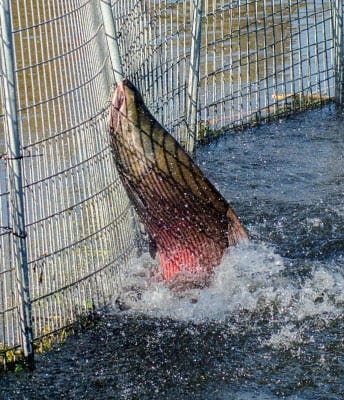Wallace Weir Retrofit Important Step for Central Valley Salmon

Ground breaking ceremony at Wallace Weir in Yolo Basin near Knights Landing. Photo: Jacob Katz
An important step toward supporting the rebound of native salmon populations in the Central Valley happened yesterday. The retrofit that is underway at Wallace Weir on the Yolo Bypass is a joint effort of farmers, conservationists and government agencies and will significantly reduce the number of adult salmon that go astray in agricultural drainage canals along the Sacramento River.
The Wallace Weir Fish Rescue project will help prevent adult Sacramento River salmon from swimming into a drainage ditch that leads deep into farm fields where spawning is hopeless. By building a permanent barrier across the Knights Landing Ridge Cut, the agencies will be able to better control farm drainage releases to avoid attracting salmon. A new fish collection facility adjacent to the weir will allow the California Department of Fish and Wildlife to more effectively capture stray salmon and return them to the river to spawn.
Salmon caught in drainage canal. Photo: Carson Jeffres
Today it would be hard to purposely design a system that would be more hostile to fish than the one we have inherited, It’s time for an update. Right now, levees and weirs separate species from the landscape. This project represents a new way that puts nature back into the mix and will make it possible to re-create fish abundance on this working agricultural landscape. Projects like this are helping to change the conversation in California from fish OR farms to fish AND farms.”
Curtis Knight, Executive Director of California Trout.
The Wallace Weir fish passage projects and others like it are integral to achieving the Brown Administration’s five-year Water Action Plan, which calls for elimination of barriers to fish migration, and the Sacramento Valley Salmon Recovery Program, which is a comprehensive effort by the Northern California Water Association, Sacramento River Settlement Contractors, the Nature Conservancy, American Rivers, and California Trout to help recover salmon.
For more on the ground-breaking ceremony and project, read the Press Democrat article here
The Wallace Weir project is part of CalTrout’s Central Valley Fish and Floodplains Keystone Initiative which demonstrates that water infrastructure improvements provide multiple benefits for farms and fish. By allowing fish to access and benefit from functioning floodplains, robust fisheries and self-sustaining populations of wild salmonids can once again be realized in the Central Valley.





